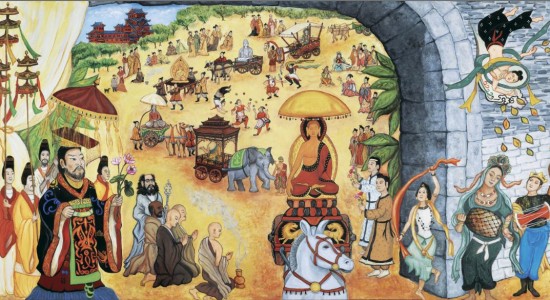Buddha's Birthday Celebration 佛誕 / 浴佛


Over 1000 carriages of Buddha statues paraded the street in the city of Luoyang Northern Wei, China. This is the oldest known international celebration of a historical figure. For further details of this magnificent display refer to Parading the Buddha by Venerable Dr Juewei. Painted by Nancy Cowardin.
READ MORE:
Origin of Buddha's Birthday
Buddha’s birthday is a holiday that commemorate the birth of the Prince Siddhartha Gautama, later the Gautama Buddha; also known as Sakyamuni Buddha, the founder of Buddhism. Prince Siddhartha was born on the 8th day of the fourth lunar month or on the day of the full moon in May over 2,550 years ago in Lumbini, Kapilavatsu in Northern India (present day Nepal).
Thus, this festival is primarily celebrated in the Vaisakha month of the Buddhist calendar. In China and Korea, it is celebrated on the 8th day of the fourth month in the Chinese lunar calendar.
The Legend
According to the legend of Prince Siddhartha’s birth, his mother Queen Maya was traveling home to see her parents and had stopped to rest in the lush Gardens of Lumbini where she went into labor. It is said that auspicious signs herald his birth, the sky was clear with brilliant sunshine, flowers bloomed and birds sang.
Soon after his birth, nine heavenly dragons appeared and emitted two steams, one cool and one warm, of the purest fragrant rain from their mouths that gently cascaded to bathe the newly born Prince. The baby Prince immediately took seven steps and seven lotus flowers sprang from beneath his feet.
Flowers drifted down from the heavens. The young Prince purified in body and mind from the rain, pointed one hand towards the heavens and one towards the earth and he said, “Heaven above and earth beneath, I am the Honoured One, the One who liberates all who suffer in the Three Realms.”
Bathing of the Buddha
After the death of the Buddha, it became a tradition to bathe the statue of Buddha to commemorate his birth.
It symbolizes the cleansing of our body, speech and thoughts to eradicate anger, greed and ignorance in order to purify our minds to cultivate merits and wisdom. The universal message is that “it’s easy to wash away physical dirt, but much more difficult to cleanse one’s inner impurity of greed, anger and ignorance”. This is the true significance of bathing the Buddha.
For the bathing ceremony, the altar is arranged as a flower garden, representing the Garden of Lumbini. In following with tradition, monks and nuns use a special ladle to pour fragrant water steeped with special herbs over the statue of the infant Buddha, afterwards the image is rinsed with purified water. The ritual performed with reverence and a purified mind is said to improve harmony and inner balance, leading to a flourishing, fulfilling, wholesome, blissful and enlightened life.
Ritual to Bathe the Buddha
I now sincerely bathe all Tathagatas,
Gaining merits of pure wisdom and majesty;
May beings be free from defilements in all,
Thereby attain Tathagata’s pure Dharma body.
我今灌沐諸如來;
凈智莊嚴功德海。
五濁眾生離塵垢;
同證如來凈法身。
Listen to the Gatha
In the Sutra On The Merit Of Bathing The Buddha, the benefits of bathing the Buddha includes the abundance of wealth, happiness, good health, longevity, and peace of mind; the harmony of family, relatives, and friends; and be free from the eight obstacles of practicing the Dharma, and remoteness from all sufferings.
(Taisho Vol. T16, No. 698) Translated by Sramana Yijing, Tang Dynasty.

Step 1
Whilst kneeling before the altar, join palms to pay respect to the Buddha. Pick up and fill the ladle with fragrant water, and carefully pour water over the shoulder of the Buddha.

Step 2
At each pour, chant the following – 1st wash: "May I eliminate all evil thoughts." 2nd wash: "May I cultivate good deeds." 3rd wash: "May I help deliver all living beings."
